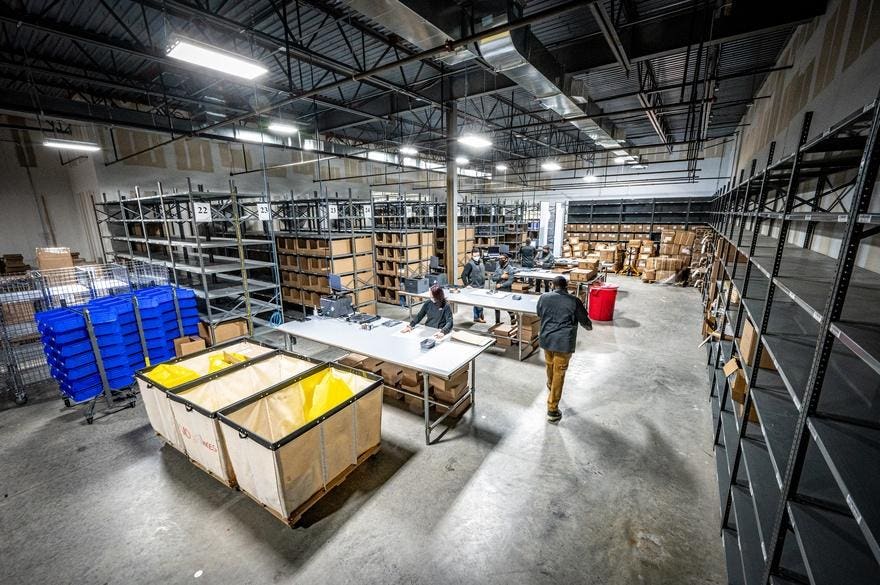Material handling and manufacturing industry data strengthened in January. The Institute for Supply Management manufacturing index rose to the strongest level since September 2022, while the MHI Business Activity Index by Prestige Economics reflected expansions across most categories, including business activity, new orders, future new orders, shipments, and capacity utilization. Unfilled orders and exports were flat for the month. On the downside, inventories contracted. Over the next two years, there are reasons to be optimistic because interest rates have started falling and are likely to fall further through the end of 2026, supporting material handling, manufacturing activity, and economic growth on trend.
Material Handling Industry Data Strengthened in January
Material handling data improved in the Feb. 3, 2025, release of the January 2025 MHI Business Activity Index by Prestige Economics — known in shorthand as the MHI BAI. This is the most real-time economic data available for the U.S. material handling industry.
The material handling industry is comprised of manufacturers, technology providers, and other suppliers who provide the hardware and software to move goods through the U.S. and global supply chains. Data in the MHI BAI comes from leading executive members of MHI, which is the largest material handling, logistics, and supply chain association in the United States.
U.S. manufacturing expanded in January as the Institute for Supply Management manufacturing index rose to 50.9, above the breakeven of 50 and at the strongest reading in the series since September 2022. The ISM manufacturing index had improved in recent months, approaching the breakeven level of 50. This series is a key leading indicator of U.S. economic growth, and its January expansion bodes well for U.S. Q1 2025 GDP.
The MHI BAI also bodes well for Q1 2025 GDP since January data collected from MHI executives reflected expansions across most categories, including business activity, new orders, future new orders, shipments, and capacity utilization. Meanwhile, there was only a monthly contraction in inventories. Unfilled orders and exports were flat for the month of January.
The January MHI BAI strengthened from recent reports, especially the weak December 2024 MHI BAI report, which reflected contractions in five series and expansions in only three series.
Material Handling Shipments Expanded In January
Shipments have been consistently expanding over the past few years in MHI BAI reports. In January, MHI BAI shipments expanded, as 55% of respondents reported contractions in shipments, and only 45% reported expansions.
MHI BAI series readings above 50 indicate that a majority of the respondents reported increased monthly activity, while readings below 50 indicate a majority of respondents noted decreased activity.
New orders were also positive and expanded, as 59% of respondents reported monthly expansions in new orders. Despite an expansion in January, new orders have been mixed over the past two years, reflecting expansions in 14 of the past 24 months. Meanwhile, shipments have contracted only five times in the past 24 months.
In stark contrast to shipments, unfilled orders and inventories have been persistently weak.
Unfilled orders were flat in January, as 50% of respondents reported monthly contractions and 50% reported expansions. Persistently weak, unfilled orders have only expanded six times in the past 24 months.
Inventories contracted in January, as only 42% of respondents noted monthly expansions, but 58% noted contractions. This was the 16th consecutive monthly contraction in inventories, which expanded just twice in the past 24 months.
The trend over the past two years of the relative strength of shipments compared to the weakness of new orders, unfilled orders, and inventories appears to indicate that companies have been burning off their backlogs and running down work-in-progress inventories.
Strong Material Handling Future New Orders Accelerated
MHI BAI future new orders have been strong and were at 95% in January. This percentage shows that almost all respondents expect future new orders will be higher in 12 months. Moreover, this monthly series accelerated in January. As a result, the January three-month average for the future new orders series accelerated to 93%, and the six-month average accelerated to 94%.
These expansion percentages are exceptionally high and bode well for the future of material handling new orders in the year ahead.
Beyond the strength in future new orders, there is additional upside potential for material handling activity in the year ahead. Interest rates have started falling and are likely to fall further through the end of 2026, according to recent Fed member forecasts. A drop in U.S. interest rates and a likely accompanying drop in the dollar are likely to support material handling and manufacturing on trend over the next two years.
Material Handling Outlook Implications For The U.S. Economy
In making predictions about the future of the U.S. economy, both the ISM and MHI BAI data should be watched closely because growth dynamics for material handling offer a glimpse into consumption and aggregate economic demand.
With high expectations for future new orders along with expanding current new orders, the outlooks for material handling, supply chain, and manufacturing are positive for 2025.
Recent MHI BAI reports have shown solid expansions for new orders and future new orders. If those series remain positive, the overall outlook for U.S. manufacturing, material handling, and gross domestic product are also likely to be positive.
Tariff Risks For Material Handling And Manufacturing
Tariff risks could dampen the outlook for U.S. manufacturing, although that will depend on the implementation and duration of any potential U.S. and reciprocal tariffs.
The threat of potential U.S. tariffs appears to be an international policy sword of Damocles hanging above major U.S. trading partners designed to drive policy actions. Given past dynamics, as long as Canada and Mexico are making concerted efforts and meaningful progress toward supporting U.S. national security and economic security goals, tariff increases seem likely to be postponed and may not materialize.
What do you think of recent U.S. manufacturing and material handling data against a backdrop of rising trade and tariff risks?
Let me know in the comments below.
Also, be sure to subscribe to my YouTube channel and visit Prestige Economics and The Futurist Institute for additional content about the economy, financial markets, growth, manufacturing, and material handling.
Read the full article here
















